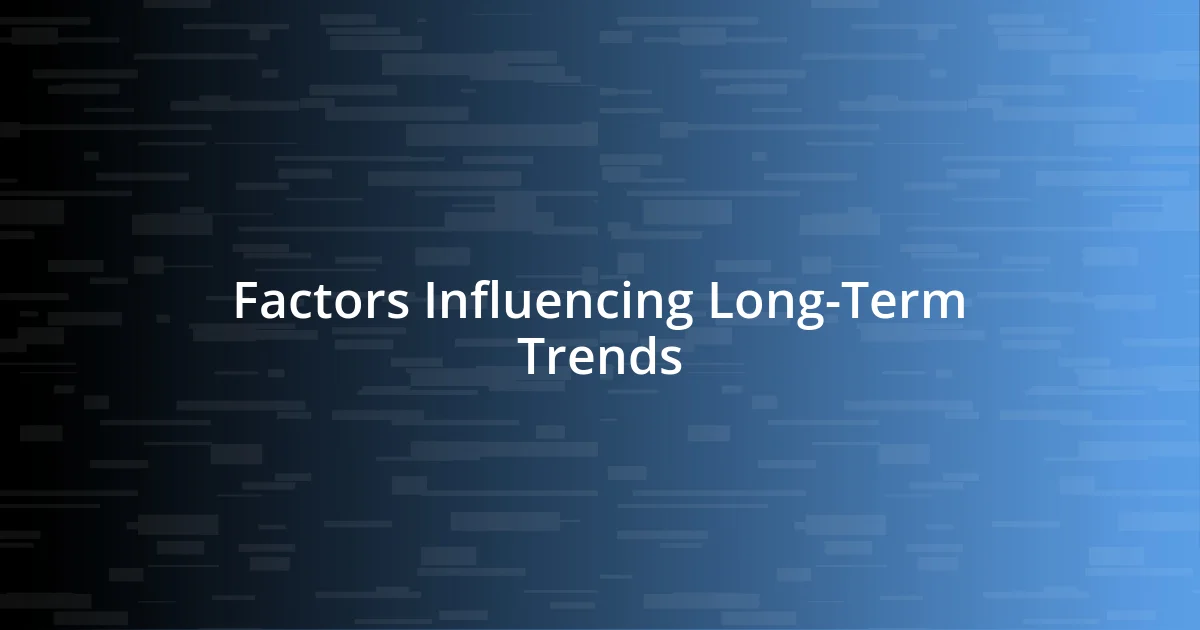Key takeaways:
- Long-term trends often emerge gradually and significantly influence daily life, as seen with the rise of technology and shifts in societal values.
- Identifying reliable trend indicators requires consistency, diverse data sources, and understanding demographic and behavioral changes, which reflect broader societal shifts.
- Developing effective long-term strategies hinges on adaptability, alignment with core values, and continuous learning to navigate changing market dynamics.

Understanding Long-Term Trends
When I think about long-term trends, I often consider the subtle shifts that shape our lives over years, maybe even decades. For example, I remember when smartphones first emerged; they slowly changed communication patterns, which now feels like a lifetime ago. Isn’t it fascinating how something that was once a novelty can transform the fabric of daily routines?
I’ve also noticed that long-term trends aren’t always easy to spot initially. They often creep up on us, like the gradual rise of sustainable living practices that I began incorporating into my own lifestyle a few years ago. With each small change, like using reusable bags or exploring plant-based meals, I felt more in tune with a greater movement. What long-term shifts in your life have you noticed, and how have they impacted your day-to-day choices?
Ultimately, understanding long-term trends is about recognizing that these shifts require time and patience. I often reflect on how societal attitudes toward remote work have evolved since I started my career. At first, it was met with skepticism, but today it feels like a standard practice. Haven’t those early adopters paved the way for a more flexible future for all of us?

Factors Influencing Long-Term Trends
As I think about the factors that influence long-term trends, I can’t help but consider the role of technology. For example, when I first experimented with online banking, it felt like a leap into the future. Now, I can’t imagine managing my finances without it. This rapid technological evolution often paves the way for new habits, propelling significant societal shifts that might not have been imaginable before.
Another factor that I find compelling is cultural change, which I feel deeply connected to. I remember when discussions around gender equality gained momentum in the workplace. It was a slow transition, but it ignited meaningful change in corporate culture. Recalling my own experiences, I’ve seen how companies became more inclusive and how that not only enhanced morale but also productivity. Doesn’t it show how cultural values can reshape our environment over time?
Lastly, economic influences cannot be overlooked. During the economic downturn I experienced a few years ago, I noticed a significant shift in consumer priorities. People became more budget-conscious and leaned toward sustainable products. I, too, adapted my spending habits, opting for local produce instead of imported goods. It’s interesting to observe how economic conditions can trigger a collective re-evaluation of what truly matters to us.
| Factor | Description |
|---|---|
| Technology | Advancements lead to new habits and behaviors. |
| Cultural Changes | Shifting values can redefine workplace dynamics and societal norms. |
| Economic Influences | Financial conditions can reshape consumer priorities and behaviors. |

Identifying Reliable Trend Indicators
Identifying reliable trend indicators can be quite a journey. I often look for patterns that resonate emotionally with me, as these signals often touch the pulse of society. For instance, during my daily commutes, I noticed more people reading e-books instead of physical ones, suggesting a shift towards digital literacy. This subtle observation sparked my curiosity, and it helped me realize that reading habits are evolving alongside technological advancements.
To fine-tune my ability to spot these indicators, I consider several key aspects:
- Consistency Over Time: Indicators should show persistent behavior or trends rather than fleeting moments.
- Diverse Sources of Data: I pay attention to various reports, social media sentiments, and market analyses to create a well-rounded understanding.
- Demographic Shifts: Keeping an eye on changing age groups, lifestyles, and cultural backgrounds can provide critical insights.
- Behavioral Changes: I find it essential to notice how consumer behavior adapts in response to economic or environmental factors.
- Expert Opinions: Engaging with thought leaders in different fields enriches my perspective and helps me gauge the reliability of emerging trends.
It’s a thoughtful process, but honing in on reliable indicators feels like uncovering pieces of a larger puzzle.

Evaluating Historical Data Patterns
Evaluating historical data patterns offers a fascinating glimpse into the dynamics of change over time. I recall poring over economic statistics during a graduate research project, where I stumbled upon data about consumer spending before and after major recessions. It was striking to see how people’s purchasing habits morphed based on economic stress. Have you ever noticed how certain brands thrive during tough times while others seem to vanish? This reinforces the idea that data isn’t just numbers; it reflects human behavior and societal priorities.
In another instance, while browsing historical fashion trends, I was intrigued to find that styles often mirrored societal upheaval or tranquility. For instance, the boldness of the 1960s fashion revolution echoed a generation seeking liberation. Observing these correlations made me wonder: what future styles might emerge from the current cultural climate? Historical patterns act like windows into the soul of society, allowing us to predict its trajectory more accurately.
Ultimately, working with historical data requires a keen eye and a knack for storytelling. I remember analyzing shifts in music genres—how the rise of hip-hop in the late 20th century was not merely about sound; it was a powerful narrative of cultural identity and resilience. Such patterns can be incredibly telling, and I find that evaluating them allows us to honor our past while shaping our future. Isn’t it fascinating how our history can guide our decisions today?

Analyzing Current Market Conditions
Market conditions today reveal intricate layers of complexity that often go unnoticed. I’ve found that paying attention to everyday experiences can provide insights into the broader economic landscape. For example, during a recent grocery run, I noticed price tags became a topic of conversation among shoppers, highlighting growing concerns about inflation. Have you experienced this shift in your own shopping habits? Such interactions remind me that consumer sentiment captures the essence of prevailing market conditions.
Navigating the financial news these days feels like sailing through choppy waters. I often reflect on how geopolitical tensions impact local economies and consumer confidence. Just last week, while chatting with a colleague, we discussed how uncertainty can lead to cautious spending. It’s interesting to consider—when people feel insecure about their future, do they really invest in new technologies or trends? This constant tug-of-war between fear and opportunity shapes the current market narrative.
Every so often, I catch myself monitoring social media buzz about emerging companies. Recently, I saw a surge in discussions around eco-friendly startups, signaling a growing shift toward sustainability. This piqued my interest: is this just a passing trend, or a fundamental change in consumer values? Analyzing such conditions isn’t merely about numbers and charts; it’s about understanding how our collective consciousness is evolving, and that, I believe, can forecast long-term trends effectively.

Predicting Future Trends Effectively
Recognizing and interpreting signals from the present moment is crucial for predicting future trends effectively. I recall a time when a friend and I attended a tech conference. Amidst the buzz, we found ourselves drawn to a start-up booth showcasing virtual reality (VR) applications for education. It struck me how the excitement surrounding this technology mirrored a broader shift in how we view learning environments. Have you ever felt that change in the air, when something just clicks into place? That’s the kind of insight we can gather by staying attuned to current innovations and the conversations they inspire.
Contextualizing trends is another powerful tool I’ve learned to appreciate. A while back, I participated in a community art project aimed at addressing local social issues. The conversations we had around the project unveiled an underlying desire for more community-focused initiatives. This realization made me ponder: how often do we miss the opportunity to connect current events to nascent movements? By diving deeper into emerging dialogues, we can glean valuable perspectives on where society might be heading.
To truly anticipate future trends, it’s essential to look at the convergence of technology, culture, and consumer behavior. I was recently struck by how my own social circle is increasingly embracing plant-based diets, driven by concerns about sustainability and health. It’s fascinating how personal choices reflect wider societal shifts, isn’t it? Recognizing these interconnected patterns allows us to predict trends not just as isolated phenomena, but as part of a larger, evolving narrative.

Developing a Long-Term Strategy
Developing a long-term strategy requires an understanding of not just the current landscape but the nuances that define its trajectory. Recently, I was brainstorming business ideas with a friend when we stumbled upon the importance of adaptability. We felt that volatility shouldn’t derail progress but rather drive innovation. Have you noticed how some businesses thrive during turbulent times? This resilience is often the result of a well-crafted long-term strategy anchored in flexibility.
When I think about implementing a long-term strategy, I focus heavily on aligning vision with core values. During a recent workshop, we were tasked with designing a project based on our personal values. I imagined how this concept could translate into a business model that prioritizes ethics as much as profit. What if aligning company goals with genuine values could lead to sustained engagement with customers? From my experience, when organizations communicate a clear sense of purpose, they cultivate loyalty that lasts beyond mere transactions.
Finally, I believe that continuous learning and assessment are vital for any long-term approach. Reflecting on my experiences, I remember taking a course on strategic foresight that emphasized the role of feedback loops. It struck me: strategies need to evolve just as much as market dynamics do. Do you ever feel overwhelmed by all the data we have at our fingertips? The key is not to merely collect information but to integrate it meaningfully into our decision-making processes. By embracing a mindset of growth and evaluation, we can better navigate the complexities of our chosen paths.














